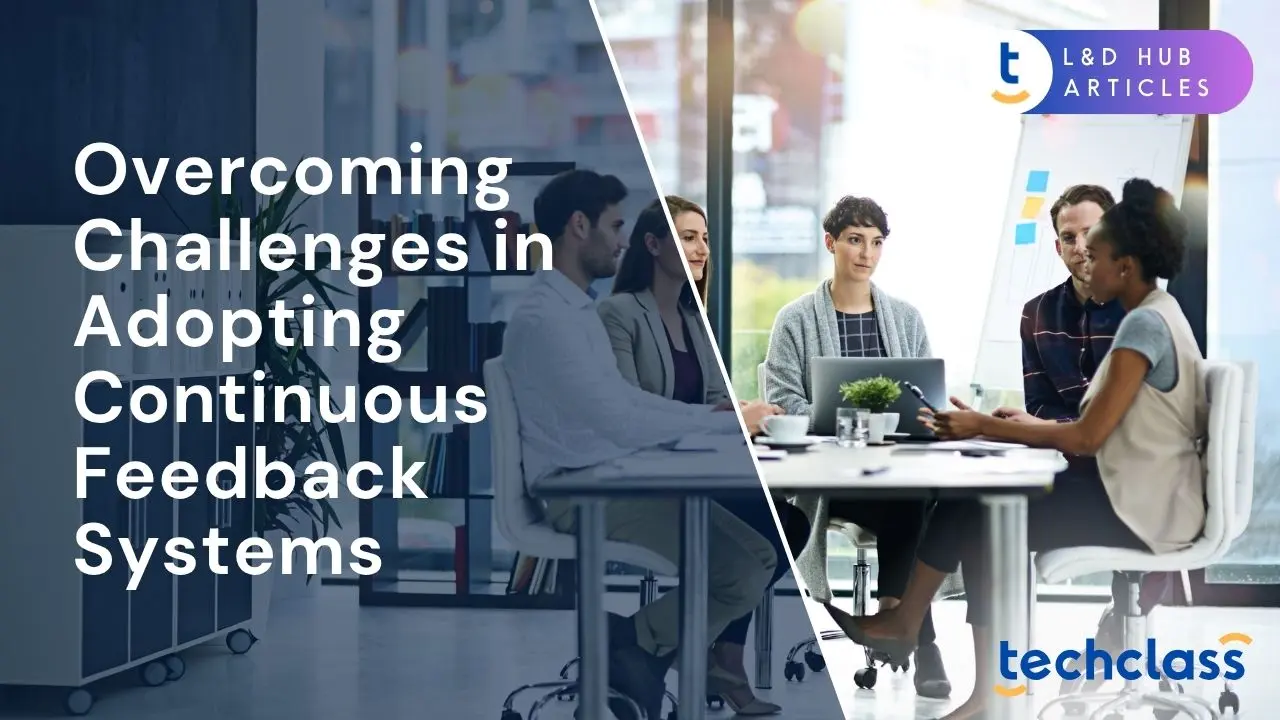
In today’s fast-paced business environment, companies are recognizing that the traditional annual performance review is no longer sufficient. Employees, especially in modern, agile workplaces, crave timely input rather than waiting a full year for feedback. Many organizations have started adopting continuous feedback systems, processes where managers and peers provide real-time, ongoing feedback to employees. This shift promises numerous benefits: improved engagement, faster development, and a culture of open communication. In fact, research indicates that businesses moving from yearly appraisals to continuous feedback see significant gains (for example, one study noted a 15% improvement in employee performance and 20% higher engagement after such a transition). Forward-thinking companies like Adobe, Microsoft, and Deloitte have already transformed their performance management by emphasizing frequent check-ins over once-a-year evaluations. Adobe’s own move to a “Check-In” continuous feedback approach reportedly led to a 30% drop in voluntary turnover and saved managers tens of thousands of hours previously spent on filling out annual review paperwork. Clearly, the promise of continuous feedback is compelling: employees stay more motivated and aligned, and organizations become more responsive and people-focused.
Yet making this shift is not without hurdles. Many HR professionals and business leaders encounter challenges when trying to implement continuous feedback in their organizations. Resistance to change, lack of time, and uncertain processes can all impede these well-intentioned initiatives. How can a company overcome such obstacles and realize the full benefits of a continuous feedback system? This article explores the common challenges in adopting continuous feedback systems and offers practical strategies to address them. By understanding both the pitfalls and solutions, HR leaders and enterprise managers can successfully foster a culture of continuous feedback that drives performance and growth.
One of the greatest challenges in adopting continuous feedback is overcoming the cultural and mindset barriers within an organization. A continuous feedback system will falter if the company’s culture isn’t ready to support open, two-way communication. Resistance to change is a natural human tendency, managers and employees who are accustomed to traditional reviews may be wary of a new approach. They might fear that frequent feedback could turn into micromanagement or expose mistakes more often. In hierarchical environments, employees may hesitate to speak up or share candid feedback upward, worrying about repercussions. For continuous feedback to take root, leaders must actively cultivate a safe and trust-based culture.
Start by securing leadership buy-in and role modeling. Senior leaders and executives should visibly endorse the value of continuous feedback, framing it as a positive tool for growth rather than a punitive measure. When top management regularly asks for feedback on their own performance and acts on it, it sends a powerful message that everyone’s input is valued. This top-down support is crucial, as with any cultural change, if management is not convinced and supportive, employees will likely remain skeptical.
Next, focus on communicating the benefits of continuous feedback to all levels of staff. Employees and managers need to understand why the organization is making this change. Emphasize that the goal is to support development, improve teamwork, and address issues in real-time, not to find fault or add extra pressure. Share statistics or case studies that highlight benefits, for example: companies with strong feedback cultures have measurably lower turnover and higher performance than those without. When people see that regular feedback can lead to personal growth, better team outcomes, and even improved business results, they become more open to giving it a chance.
Creating a psychologically safe environment is also essential. Employees must feel confident that they can offer honest feedback (even to their bosses) or receive constructive criticism without fear of punishment or embarrassment. HR and leaders should reinforce that feedback, whether positive or negative, is meant to help, not hurt. One way to build this trust is to encourage a focus on future improvement (often called “feedforward”) rather than dwelling on past mistakes. By keeping feedback conversations solution-oriented and forward-looking, the process feels less like judgment and more like coaching. Over time, as team members see that voicing concerns or ideas leads to positive changes (and no one is punished for speaking up), a true feedback-friendly culture will emerge.
Finally, involve employees in the journey. Solicit feedback about the feedback process itself. Involve a group of employees and managers in piloting the continuous feedback approach and ask for their opinions. By engaging people early and showing that their input is shaping the new system, you reduce resistance. People are far more likely to embrace a change that they had a hand in crafting. Through open communication, reassurance, and leading by example, organizations can gradually break down cultural barriers. The result is a workplace where continuous feedback is seen not as a scary new mandate, but as a natural, welcomed part of daily work life.
Even with a supportive culture, a continuous feedback system can stumble if managers and employees lack the skills to give and receive feedback effectively. Under traditional annual reviews, many managers only provide formal feedback once or twice a year, and some employees have little practice in responding to or seeking feedback. Shifting to continuous conversations requires a mindset change and skill development for everyone involved. One common challenge is that managers might not know how to deliver frequent feedback in a constructive, motivating way. Likewise, employees might feel defensive or anxious if they suddenly start getting more regular critiques. Training and education are key to overcoming this hurdle.
First, organizations should invest in feedback training for managers. Managers need to learn how to coach rather than just evaluate. This includes learning techniques for providing feedback that is specific, objective, and focused on behaviors (instead of personal attributes). One helpful model is to frame feedback using context: for example, “In [situation], I observed [behavior]. Here’s the [impact] it had…”, this helps keep discussions factual and clear. Managers should also be trained to balance positive and constructive feedback. Research shows that positive reinforcement can dramatically boost engagement (some surveys find positive feedback increases engagement far more than solely pointing out negatives). If managers only give criticism, employees may become demoralized or start dreading every conversation. By teaching managers to acknowledge achievements and strengths regularly, alongside areas for improvement, continuous feedback will feel more encouraging and fair.
Another critical skill is active listening and empathy. Continuous feedback is a two-way street, managers must not only give feedback but also listen to employees’ perspectives and needs. Training sessions can include role-playing exercises where managers practice listening without interrupting, asking open-ended questions, and thanking employees for their input. When employees feel heard during feedback dialogues, they are more likely to accept and act on suggestions. Large companies have seen success with programs to upskill their leaders in communication; for instance, IBM launched an internal academy focusing on active listening and saw a notable rise in engagement after managers applied those skills. Ensuring managers are comfortable with having frequent developmental conversations is perhaps the most important investment to make.
Employees, too, can benefit from guidance on how to receive and use feedback. Consider workshops or team discussions about the value of feedback, helping staff see it as an opportunity rather than a personal attack. Teach techniques for processing feedback calmly and professionally, such as taking notes, asking clarifying questions, and jointly brainstorming solutions with their manager. Some organizations introduce the concept of a “growth mindset” to employees, encouraging them to view feedback as fuel for growth. When employees expect continuous feedback and are trained to incorporate it, they become active participants in the process. They may even begin to seek feedback proactively once they realize it can accelerate their career development.
Finally, broaden the training scope to include peer-to-peer feedback where appropriate. In a robust continuous feedback system, not all input comes top-down; colleagues might share insights with each other regularly. Teaching teams how to respectfully give feedback to peers (for example, during project retrospectives or after collaborative tasks) can further strengthen the feedback culture. It’s also useful to establish some guidelines or ground rules for continuous feedback across the organization. For example, guidelines might include: focus on behaviors and results, be timely (give feedback soon after events), keep feedback private and respectful, and don’t forget positive feedback for good work. By aligning everyone on what good feedback looks like, the company ensures consistency and fairness in the new system.
With well-trained managers and employees, the continuous feedback system transforms from a source of anxiety into a powerful engine for learning. People become more adept at having honest conversations. Managers turn into coaches who guide their teams with regular input, and employees become more resilient and improvement-oriented. This skill-building removes a major adoption barrier, replacing uncertainty with confidence in using continuous feedback day-to-day.
Another practical challenge in adopting continuous feedback is figuring out when and how to fit these frequent conversations into the busy schedules of work. Many managers initially worry: “Do I have to sit down with each team member every day for feedback? I barely have time as it is!” Similarly, employees might feel overwhelmed if they think they’ll be constantly evaluated or need to provide input on everything. Time constraints and feedback overload are real concerns. Without a plan to integrate feedback smoothly into normal work routines, a continuous feedback initiative could fizzle out or frustrate people. The good news is that with thoughtful structuring, continuous feedback can be woven into existing processes rather than becoming an extra burden.
One strategy is to establish a regular cadence for check-ins that is frequent but not excessive. Continuous feedback doesn’t mean managers must give feedback every hour of every day; it means feedback happens throughout the year as needed, instead of saving it all up. Many organizations find a rhythm that works for them, for example, brief one-on-one meetings every month or quarter, supplemented by quick feedback conversations after major projects or key events. Setting a predictable schedule for feedback check-ins can alleviate anxiety. Employees know they will have dedicated time to discuss progress, and managers can plan these conversations into their calendars. These check-ins need not be long: even a 15-30 minute focused conversation can be effective if done regularly. By balancing frequency with practicality, companies avoid “feedback fatigue.” For instance, a weekly detailed review might be too much in most settings, but a monthly chat with timely comments on recent work is often very manageable.
It’s also important to keep feedback sessions focused and relevant so that they don’t feel like a waste of time. Encourage managers and employees to come prepared to their check-ins with specific topics. They might review progress on goals, reflect on what went well recently, and discuss one or two things that could be improved or adjusted. If every feedback conversation has a clear purpose (like solving a current challenge or developing a particular skill), it will feel useful rather than like a perfunctory chat. Structure can help here: some companies use a simple template or agenda for check-ins, for example: “What achievements or progress are you proud of since our last talk? Any challenges you’re facing? Here’s some feedback I have for you on recent work, and I’d love your feedback for me as well. Let’s agree on next steps or support needed.” Following a consistent format ensures important points are covered efficiently each time.
Another challenge is aligning continuous feedback with performance evaluations and rewards. A common question from HR is: if we move away from an annual review rating, how do we decide on raises, promotions, or bonuses? The solution many have found is to decouple the developmental feedback from compensation decisions, at least in timing. For instance, continuous feedback conversations throughout the year focus on growth and coaching. Then, perhaps once a year, managers can still summarize performance for the purposes of compensation and career progression decisions. The difference is that by the time any formal evaluation happens, neither the manager nor the employee is surprised by the content, after all, they’ve been discussing performance all along. In fact, continuous feedback makes year-end reviews (if they exist at all) much easier and less stressful, since they become a recap of conversations already had. Organizations like General Electric and Netflix that pioneered continuous feedback ended up removing formal ratings entirely, choosing instead to have managers make reward decisions based on their accumulated understanding of employees’ work. Others combine approaches: keeping a lightweight annual review mainly for documentation and pay decisions, while using ongoing feedback to drive daily performance. Whichever approach, it’s important to communicate to employees how continuous feedback ties into (or doesn’t tie into) formal evaluations, so they know what to expect. This clarity prevents confusion and builds trust that the new system is fair.
To avoid feedback overload, companies should also stress quality over quantity. Managers shouldn’t feel obligated to give feedback on every minor detail, nor should employees be pressured to constantly critique. The aim is not to inundate people with commentary, but to ensure meaningful feedback reaches them when it can help. If some teams are worried about too many feedback interruptions, consider designating certain times or channels for feedback. For example, an agreement that non-urgent feedback will be shared during weekly team meetings or in a monthly email summary might help compartmentalize the process. Additionally, fostering a two-way feedback norm means employees can tell managers if they need a bit of space, for instance, an employee under pressure might say, “I appreciate the feedback, but can we schedule a detailed discussion next week when this deadline is passed?” Continuous feedback should be flexible and humane, not a rigid constant critique.
By thoughtfully integrating feedback into regular workflows and clarifying its role, organizations can overcome the logistical challenges. Managers and employees will find that continuous feedback, rather than adding work, actually streamlines communication and prevents bigger issues down the line. It becomes a natural part of how work gets done, much like agile teams do frequent check-ins (stand-ups) to stay on track, any team can use brief feedback loops to keep performance on track. Over time, these practices save effort: small course corrections throughout the year mean there are fewer fire drills or end-of-year surprises to deal with. In summary, integrating continuous feedback is about making it routine, focused, and aligned with existing performance processes so that it enhances productivity rather than hinders it.
Technology can play a pivotal role in overcoming challenges associated with continuous feedback systems. In the era of digital tools, organizations have an opportunity to use software and platforms to facilitate easier, timely feedback exchanges, but technology must be used thoughtfully to complement human conversation, not replace it. One challenge firms often face is scaling continuous feedback across large or distributed teams. When you have a workforce spread across different locations (or working remotely), maintaining consistent feedback can be tricky. This is where modern performance management and feedback tools come in handy. Companies are increasingly adopting dedicated feedback platforms or integrating feedback features into existing HR systems. These tools allow employees and managers to give quick feedback notes, send recognition, or request input with just a few clicks. For example, some platforms enable a worker to request feedback from a project teammate right after completing a task, or allow a manager to quickly record praise for a job well done and share it. For global organizations, such technology standardizes the process, everyone uses the same system, ensuring that feedback isn’t lost or siloed in email threads or hallway conversations.
Implementing a feedback tool, however, can come with its own learning curve. Adoption and ease-of-use are important considerations. To overcome the hurdle of “yet another system” fatigue, choose tools that are user-friendly and accessible on the devices your employees already use (like mobile apps or integrations with chat platforms). Provide training or quick tutorials so that people understand how to use the tool effectively. It’s also wise to clarify that the tool is an aid, not a surveillance device; employees might initially be concerned that a digital system will track every comment or create permanent records of mistakes. Assure them that the intent is to make giving feedback simpler and more timely, for instance, someone can jot down feedback in the system when it’s fresh in mind, instead of forgetting it by the next meeting. Some tools allow feedback to be given anonymously or in aggregate, which can help in collecting upward or peer feedback candidly. Using technology can thus reduce logistical barriers: feedback can happen asynchronously (no need to wait for the next meeting) and can involve multiple perspectives (360-degree feedback) with ease.
On the flip side, it’s crucial to balance technology with human touch. Over-reliance on apps can inadvertently make feedback feel impersonal if not managed well. Encourage managers to still have face-to-face (or video call) discussions for substantive feedback whenever possible, rather than only typing comments into a system. The tech should support real conversations by keeping records, prompting feedback cycles, and highlighting issues, but it shouldn’t eliminate personal dialogue. For example, a tool might remind a manager that it’s been 4 weeks since their last check-in with an employee, or it might compile positive feedback that colleagues have given about a person so the manager can mention it in their next conversation. Used this way, technology actually frees up time and provides data for richer, more informed interactions. It can also track goals and feedback themes over time, which helps in measuring impact and ensuring follow-through on improvement plans.
Another benefit of leveraging technology is the ability to analyze feedback trends and measure engagement. Many continuous feedback platforms offer analytics dashboards. HR teams can monitor metrics such as participation rates (e.g., what percentage of employees have received feedback this month), feedback sentiment (perhaps through pulse surveys or text analysis), and correlations between feedback activity and outcomes like employee engagement scores or turnover. Having this data allows the organization to identify where the continuous feedback system is working well and where it may need adjustments. For instance, if one department shows little feedback exchange, it might signal a need for extra support or leadership attention in that area. Or analytics might reveal that prompt recognition for good work (a form of positive feedback) is linked to higher morale. These insights help in continuously improving the feedback culture itself.
In summary, technology can greatly assist in overcoming adoption challenges by streamlining feedback, bridging distances, and providing structure. However, it should be introduced as part of a broader strategy that values human connections. By selecting the right tools and implementing them with proper training and communication, organizations can make continuous feedback more efficient and broadly accessible. The end result is a seamless feedback loop: an employee can receive a piece of feedback or recognition in real-time via a notification, reflect on it, discuss it with their manager if needed, and adjust their work accordingly, all with minimal friction. When tech and culture work hand-in-hand, continuous feedback truly becomes a natural, effortless element of the workday.
Looking at how other organizations have navigated the shift to continuous feedback can provide inspiration and confidence. Several well-known companies have successfully overcome adoption challenges and built strong feedback cultures, leading to tangible improvements in engagement and performance. Here are a few notable examples and lessons from their journeys:
These examples underline a few common themes in overcoming adoption challenges. Firstly, leadership and communication made a difference, each company had leaders who clearly backed the new system and communicated its purpose. Secondly, they invested in training and tools to help managers and employees adjust, be it Adobe’s manager training, Deloitte’s streamlined tools for weekly input, or Google’s feedback platform. Thirdly, they each addressed the fear factor head-on: by removing ratings (Adobe, Deloitte), ensuring safe channels (Google), or normalizing casual conversations (Starbucks), they reduced the anxiety around feedback. As a result, these organizations transformed feedback from a dreaded event into a continuous, normal practice that drives positive results.
For any HR professional or business leader reading this, these case studies serve as encouragement that the challenges of implementing continuous feedback can be overcome. It may take time and persistence, but the payoff, more engaged employees, better talent retention, and higher performance, is well worth it. By applying similar strategies of clear commitment, equipping people with skills, leveraging technology, and keeping the process human-centric, your organization can join the ranks of those who have made continuous feedback a cornerstone of their success.
Transitioning to a continuous feedback system is a significant change, and it’s normal for organizations to encounter obstacles along the way. However, as we’ve explored, none of these challenges are insurmountable. With the right approach, companies can transform feedback from a source of fear or frustration into a dynamic force for improvement and engagement. The journey begins with understanding the cultural shift required, moving from a once-a-year evaluative mindset to a continuous, growth-oriented dialogue. By fostering trust and openness, providing training and support, integrating feedback into regular workflows, and using technology smartly, any organization can create an environment where feedback thrives.
The benefits of overcoming these challenges cannot be overstated. When continuous feedback becomes part of the company DNA, employees feel heard and valued, managers become better coaches, and small issues get addressed before they turn into big problems. Over time, this leads to a more agile and resilient organization. Problems are solved faster, good work is recognized sooner, and people are constantly learning. In a business landscape where adaptability and employee experience are key, a feedback-driven culture gives organizations a clear competitive edge.
For HR professionals and leaders, the path forward is about commitment and continuous refinement. Start small if needed, pilot the approach in one department, gather feedback on the process, and iterate. Celebrate early wins, like improvements in team morale or productivity, to build momentum. It’s also important to remain patient and persistent; habits won’t change overnight. There may be setbacks, a manager who reverts to old ways or a team that’s slow to engage, but keep reinforcing the principles and benefits. Solicit feedback about how the new system is working and demonstrate a willingness to adjust it. In essence, practice what you preach: use feedback to improve the feedback process itself.
In conclusion, adopting a continuous feedback system is more than an HR initiative; it’s a strategic move toward a more responsive and people-centric organization. By proactively addressing the challenges of adoption, you pave the way for a culture where continuous improvement is the norm. The organizations that have embraced continuous feedback are already reaping rewards in employee retention, engagement, and performance. Your organization can do the same. The future of work is feedback-driven, a future where employees and employers collaborate in real-time to achieve shared success. By overcoming the initial challenges and staying the course, you’ll be well on your way to building a workplace where everyone has the opportunity to grow, contribute, and thrive through the power of continuous feedback.
Challenges include resistance to change, lack of time, uncertain processes, cultural barriers, and fear of feedback overload.
By securing leadership buy-in, promoting open communication, fostering trust, encouraging a growth mindset, and involving employees in the process.
Managers need coaching skills, active listening, and feedback delivery techniques; employees benefit from guidance on receiving feedback and adopting a growth mindset.
Technology facilitates easy feedback exchange, standardizes processes across teams, provides analytics, and integrates real-time recognition, while complementing human interaction.
Through strong leadership support, comprehensive training, shifting away from ratings, normalizing informal conversations, and leveraging technology to streamline feedback.
It ensures feedback becomes a routine, timely, and relevant part of work, reducing surprises, enhancing development, and improving performance.


